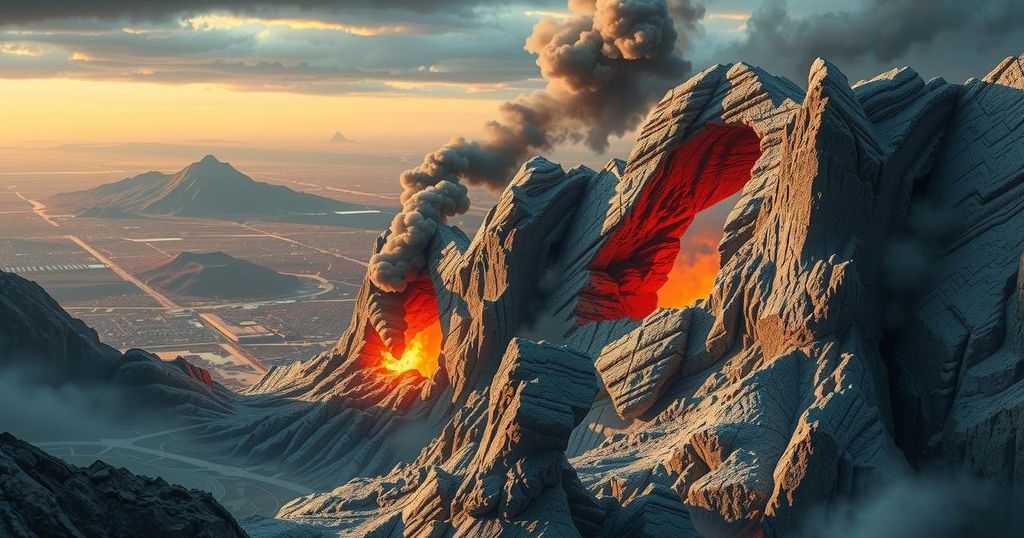This article reviews the five largest earthquakes in history, including the catastrophic 2004 Indian Ocean earthquake and tsunami, the Japan earthquake and tsunami of 2011, and significant quakes in Russia, Alaska, and Chile. It explores the devastating impacts of these seismic events and their historical significance, highlighting the notable concentration of such disasters within the Pacific “Ring of Fire.”
Throughout history, catastrophic earthquakes have left indelible marks on societies, claiming lives and causing monumental destruction. The Boxing Day earthquake of 2004, which registered a momentous 9.1 on the Richter scale, is perhaps one of the most tragic, resulting in over 230,000 fatalities across several nations. Notably, most significant earthquakes are concentrated in the Pacific region, particularly within the perilous area known as the “Ring of Fire.” This article chronicles five of the largest earthquakes recorded to date, shedding light on their impact and historical significance.
5. Russia (1952): Magnitude 9.0 – On November 4, 1952, an earthquake registering 9.0 shook the Severo-Kurilsk region in East Russia, leading to local tsunami waves reaching 50 feet. The disaster claimed the lives of an estimated 10,000 to 15,000 individuals, particularly affecting the local population as they were caught unprepared by subsequent tsunami waves.
4. Japan (2011): Magnitude 9.0 – Japan experienced its most severe earthquake on March 11, 2011, originating approximately 80 miles off Honshu’s coast. The quake triggered a series of powerful tsunamis, particularly devastating Tohoku, where waves reached up to 33 feet. The associated damage was extensive, including a catastrophic event at the Fukushima nuclear plant, leading to radiation leaks and approximately 18,000 people listed as deceased or missing.
3. Indian Ocean (2004): Magnitude 9.1 – The undersea earthquake off Sumatra, Indonesia, on December 26, 2004, resulted in the most catastrophic tsunami disaster in recorded history. The earthquake led to waves striking several nations, including Indonesia and Sri Lanka, resulting in over 230,000 deaths and significant loss to regional infrastructure and communities.
2. Alaska, USA (1964): Magnitude 9.2 – The historic Good Friday earthquake of March 27, 1964, remains the strongest recorded earthquake in the United States, with a magnitude of 9.2. This event caused major shaking for four minutes, followed by tsunami waves impacting the Alaskan and West Coast, ultimately resulting in 128 deaths and economic damages surpassing $895 million.
1. Chile (1960): Magnitude 9.4 to 9.6 – The 1960 Chile earthquake, which occurred about 100 miles from Valdivia, is recognized as the strongest earthquake ever recorded, with estimates varying between magnitudes of 9.4 and 9.6. The tremor and subsequent tsunami devastated cities along the Chilean coast, displacing around two million people and claiming approximately 1,655 lives as waves up to 80 feet impacted the shore.
The Pacific region is notoriously prone to seismic activity due to the tectonic dynamics of the Pacific plate, where over 80 percent of significant earthquakes occur. This high concentration of seismic events is primarily within an area known as the “Ring of Fire,” where several tectonic plates converge. Historical records indicate that the five most powerful earthquakes to date have all occurred in this tumultuous region, leading to widespread devastation and loss of life, which serves as a critical reminder of the force of nature.
In summary, the five largest earthquakes in history—ranging from the Chilean quake of 1960 to the catastrophes in Russia, Japan, the Indian Ocean, and Alaska—underline the devastating impact of seismic activity on human life and infrastructure. Each incident reflects the tragic possibilities of natural disasters and emphasizes the necessity of prepared responses to such geological phenomena. Understanding these events is vital in fostering resilience in vulnerable regions.
Original Source: www.standard.co.uk






